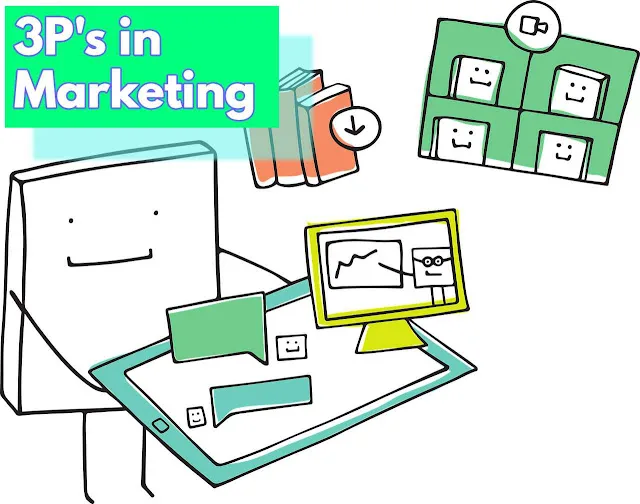We all know of the 4Ps in marketing. They make up the classical marketing mix. They are product, price, place (location where the products or services are marketed) and promotion (how the products or services are marketed).
But, recently there’s a clamour growing regarding a new set of marketing mix – one, that revolves around 3Ps.
So, I did some digging. Surprisingly, I found that while this is true, most marketers do not agree on what the 3Ps are!
Well, in simple terms, they are a new set of metrics based on which a marketing campaign should be tied to. While most disagree as to the constituents of the metrics, I have found that the 3Ps in marketing that are most favoured are –
- People
- Personalization, and
- Permission.
That said, let’s uncover these marketing 3Ps and understand how they can relate to your marketing campaign.
Note: The 7Ps of marketing are a form of marketing mix strategy, which is a must-use for any marketing campaign and is different from the 3P rules that can be used to make your marketing more effective.
What are the 3Ps in Marketing?
When you market a product or service, you need to have several factors in mind – what channels you are going to use, how will you reach your customers, how you will improve your brand image, how you are going to improve the effectiveness of your marketing campaigns etc.
For that, you need to take three main factors into consideration-
- The people who you will market to.
- How your marketing campaigns can be as personalized as possible.
- How you will ask for permission before marketing to your potential customers?
Marketing is the process of bringing a product or service to market. This can include advertising, event marketing, direct marketing, public relations and interpersonal sales. It’s also one of the biggest factors that influence whether you do well in business or not.
Who You’re Selling to? – The First of the 3P’s in Marketing

When you’re strategizing about selling your products, it’s important to determine who your target audience is going to be. Choosing the wrong target audience can lead to an unsuccessful business.
Understanding your target audience is crucial for effective marketing. Semrush provides an extensive suite of SEO and market analysis tools that can help you identify and understand your ideal customers. By leveraging its capabilities, you can ensure your marketing efforts are directed at the right ‘People’, making your strategies more effective and efficient.
Who are your target customers? Your target customers are people that have money to spend on your products and services, have interest in what you’re selling and have a need for what you’re offering. They fit into one of three groups:
1) The buyer: This consumer buys products and services just because they like them, rather than because they think they need them. They might buy things because they see them in movies or television shows, or because their friends own them, but they aren’t likely to buy anything if they don’t see any value in it.
2) The social chameleon: These consumers exist outside of any group or group attitude. They’re guys and gals who are willing to try new things out, but aren’t loyal to any particular brand. They might buy something from Nike because a friend likes
3) Those who don’t know that they need your product or services: In any niche, around 2% of individuals are looking to buy a product. The rest do not even know they have a need. It is your job to find out that these individuals have a need for your product or services.
So, how do you do it? Well, market research is a key first step.
I do not know how many times I have had to say it – you do not have a business if you do not know your customers. And, for that market research is the most essential step that any business whatsoever has to undertake.
After you’re done with market research, create a proof of concept and see if your potential customers provide a positive feedback. If they do, go ahead and create a prototype and test the waters again. If you again receive positive feedback, it means you’re on the right track and you can now develop the MVP.
These are basically part of the design thinking framework, which can be applied to any area of business. Just make sure you’re not doing any of these mistakes.
Personalization: You Can’t Do Without This – The Second of the 3P’s of Marketing
One of the most important things you can do to improve your marketing results is to make it more personal. A personalized email subject line increases open rates by up to 50%. Personalized landing pages increase conversions by up to 400%.
Personalization in lead nurturing emails improves click-through rates by an average of 14% and conversion rates by 10%.
To truly personalize your marketing campaigns and communicate effectively with your target audience, HubSpot offers a comprehensive marketing platform that supports advanced segmentation, email personalization, and customer journey mapping. Its tools are designed to make personalization at scale not just possible but straightforward, aligning perfectly with the ‘Personalization’ aspect of the 3Ps.

Here are some simple steps to improve your marketing personalization –
- Use data – Either buy relevant customer data or use data tracking softwares. However make sure you have your users’ consent or else, you’ll invite legal trouble (+ that’s the ethical thing to do!).
- Use analytics tools and market research tools.
- Progressive profiling of your audience and customers.
- Segmenting your email. list
Read these articles to learn more about personalization and their risks –
- How GDPR affects your Business
- The CAN-SPAM Act and its effect on American Businesses
- Indian Data Privacy Laws and Data Security Laws Your Business Needs to Know about
- How to Grow Your Email List
- Effective Email Outreach Tips by 19 Experts
Permission Marketing – The Last of the Marketing 3P’s
Previously, marketing was all about bombarding individuals with advertisements and sales quotes. But now, it doesn’t work.
Think about the last time you actually paid any heed to the TV ads? Even YouTube ads which are crazily personalized falls flat when compared to marketing which happens after being consented to by the end users.
This is known as permission marketing. Seth Godin has a great book on the subject.
Implementing permission marketing strategies becomes significantly easier with HubSpot. This platform excels in creating personalized email marketing campaigns that respect your audience’s preferences and consent, embodying the ‘Permission’ principle. With its robust automation features, you can ensure that each communication is timely, relevant, and, most importantly, welcome.

Permission marketing is a strategy that is rooted in treating customers and potential customers with respect. It entails asking for permission to continue communication with a person — whether that’s via email, through direct mail, or by phone.
The idea is that, somehow, the relationship has been established. Potential customers have reached out to you and asked questions about your product or service. They’ve subscribed to your newsletter, downloaded a white paper from your website, or added their name to your mailing list at a trade show. They’ve given you permission — either explicitly or implicitly — to keep in contact with them.
Permission marketing is based on the simple premise that people prefer to do business with other people who they know and trust. And if you treat them well, they will come back for more.
Although it’s an additional step in marketing to potential customers, the ones that do provide permission will be much more receptive and better qualified customers.
What’s a Marketing Mix and How are the Marketing 3Ps relevant?

The marketing mix is a familiar marketing strategy tool, which as you will probably know, was traditionally limited to the core 4Ps of Product, Price, Place and Promotion. It is one of the top 3 classic marketing models according to a poll on Smart Insights.
The Marketing Mix model (also known as the 4 Ps) can be used by marketers as a tool to assist in defining the marketing strategy. The marketing mix model consists of four elements that are controllable by an organisation: product, price, place and promotion.
The marketing mix is also called the 4 P’s of Marketing. The 4 P’s are the controllable elements that a company mixes to produce the response it wants in the target market. The variables are also known as the “marketing mix.”
However in recent times, these 4Ps are seemingly not capable of being the over-arching marketing strategy tool that they once were. So, now you need to replace them (or better yet, incorporate them) with the 3P’s of marketing.
The three Ps of marketing can help you focus your marketing efforts and provide measurable results that help you determine whether your plan is working.
1. People
The first step in any marketing plan is to identify the target audience that the company wants to reach. This can vary significantly depending on the product or service that is being marketed. For example, a fast food restaurant will target different people than a web design firm, even though both businesses are selling services to other businesses.
2. Personalization
Once you have identified who you want your customers to be, it’s important to personalize your marketing efforts. A website that sells physical products might use images of happy people using the product to convey how the product will improve their lives and make them smile. A physician, on the other hand, might include information about qualifications, quality of care and personal skills in her advertising materials.
But personalization goes far beyond that. You also need to personalize your digital marketing campaigns so as to ensure that your customers feel you are communicating with them one-on-one. Omni-channel marketing approaches are also a great way to do that.
But, if you are a startup, just focus on one channel in your online marketing and use data and analytics to customize customer interactions.
3. Permission
Many successful businesses use permission-based marketing, also called opt-in marketing. This approach involves reaching out to potential customers only when they have requested information or permission from you first.
The idea behind permission marketing is simple:
Marketers must ask customers for permission before sending them ads or information about their products and services.
Customers who give their permission are more likely to be interested in the items that are being marketed, thus making them more willing to buy.
Nowadays most individuals automatically tune out any form of advertisement or marketing message. With attention spans going down dramatically in every passing year, non-permission marketing messages are losing their effect almost completely.
In addition, permission marketing allows you to get a better message out there by learning what your customers want and what they don’t want. For example, you wouldn’t send an email advertising your new line of high heels if your customer said she doesn’t wear heels or she doesn’t like to shop online.
Permission marketing also helps you build more trust with your customers. When they see that you’re taking the time to listen to what they have to say and responding appropriately, they’ll be more willing to do business with you again in the future.
Finally, it’s important to remember that permission marketing isn’t just about getting more customers; it is also about keeping your customers and ensuring they are happy doing business with you.
What’s Wrong with the Old 4Ps and What’s so Different with the Marketing 3P’s?
The effectiveness of marketing has changed dramatically in the last couple of decades. When I first started out in marketing, a simple direct mail campaign would have a high likelihood of success.
Why?
Because there wasn’t as much competition and people were not as bombarded with advertising messages. As we all know, this has changed over the years. We are bombarded with advertising messages day in and day out.
Since traditional marketing treats everyone as a potential target, it is no wonder that so many people have learned to tune it out.
The 4Ps, that are Product, Price, Place and Promotion no longer cut it.
Why are the Marketing 3Ps so Important Now?
Your product, no matter how good, the price, no matter how less, the promotion, no matter how obtrusive, the place, no matter how relevant, won’t cut it unless you are marketing it to the right person (first P), ensuring that each person receives personalized communication (second P) and is done only after the person gives consent for the marketing.
This is why inbound marketing is so important nowadays. And, that’s why you need to have a digital marketing strategy, even if you don’t have an online business. (Related: Learn how to hire a great digital marketing agent / agency)
Digital marketing offers a never-before way to gain permission, collect customer data and personalize your marketing, as well as reach out to the right people (all the 3Ps of marketing).
Previously marketers could not afford such opportunities. But with online marketing growing at such a rate and ads having taken over the entire internet, this is the only and the best way to market to potential customers and users.
How to Use the Marketing 3P’s for Your Business
Outbound prospecting and sales are important – no doubt about that. But the usual sales messages via sending out of unsolicited messages and phone calls no longer work.
Check your email’s spam box right now.
What’s the most common thing?
None of them have your name on it. It means the mails are not personalized. This is really surprisingly. Even in our organization, all the mails that are filtered as spam never contain the recipient’s name (the most basic form of personalization).
Even if you need to at times market stuff to people without their permission, you can at least ensure that you have the other Ps of the 3Ps in place.
Do you know who you’re marketing to and if they are interested in your product or service or do you at least know why your product or service is so relevant to the recipient?
If no, then scrap the marketing campaign. If yes, then go to the second stage, personalize your marketing campaign.
In our post on email outreach, we did talk about this a little bit. But a good way to start of with personalization is by checking out the LinkedIn accounts of the recipients, their websites, their business / jobs and positions in life etc.
Now you can craft a well personalized marketing message. And, this is how you use the 3P’s in your marketing campaigns.
Wrapping it Up
The marketing 3Ps are a tool of formulating your marketing strategy. As with any other tool, they are not a comprehensive marketing solution. They need to be used in tandem with other marketing tools, strategies and tactics to deliver the best results.
As you integrate the 3Ps into your marketing strategy, organizing and tracking your efforts becomes paramount. Notion and Monday.com are two suggestions for all-in-one workspaces where you can plan, collaborate, and keep track of your marketing campaigns, ensuring that ‘People’, ‘Personalization’, and ‘Permission’ are always at the forefront of your strategy execution.
Read Next
- What are the 7 Marketing Functions and Why It’s Important for Your Business
- Using Instagram Reels for Your Small Business – The Definitive Guide
- 25 Tips to Get More Views to Your Instagram Reels
- How Law Firms are Marketing themselves (Insider Guide)
- How to Form an LLC





















